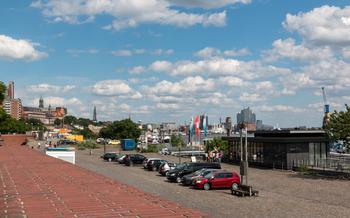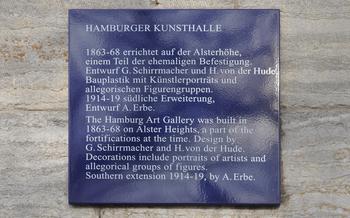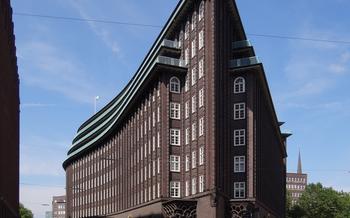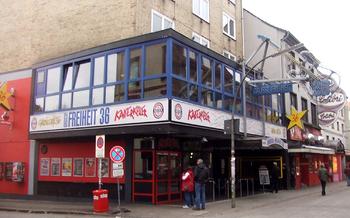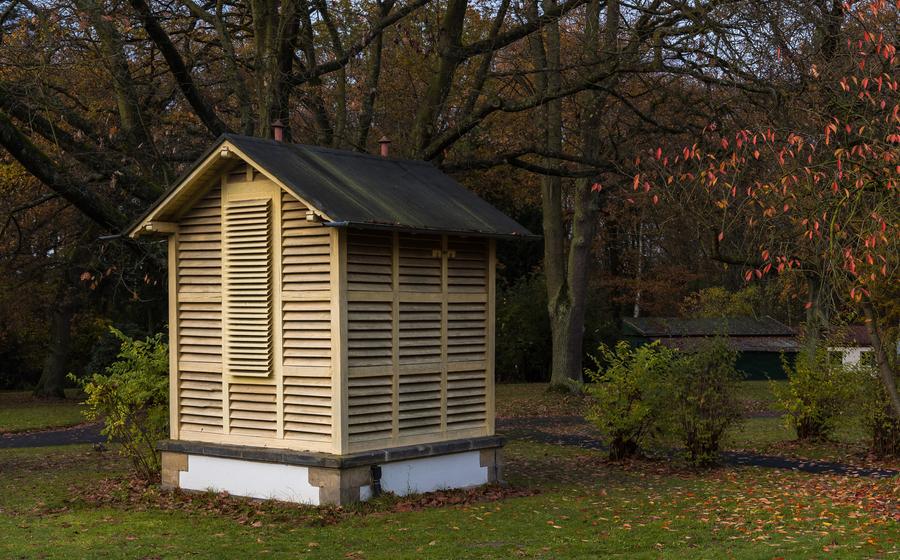
Hamburg Observatory
- Historical Significance
- Location and Accessibility
- Exhibits and Displays
- Observing the Night Sky
- Guided Tours
- Planetary Trails
- Meridian Column
- Museum of Meteorology
- Hamburg Planetarium
- Events and Workshops
- Cafe and Restaurant
- Souvenir Shop
- Photography Opportunities
- Accessibility for Visitors
- Insider Tip
Historical Significance
The Hamburg Observatory, with its rich history dating back to 1825, stands as a testament to Germany's profound contributions to astronomy and navigation. Initially founded as a university observatory, it quickly gained recognition as a leading institution for astronomical research and education. Throughout the 19th and 20th centuries, the observatory made significant discoveries, including the determination of stellar distances and the classification of stars, which revolutionized our understanding of the cosmos. Its dedication to celestial observations and the advancement of astronomical knowledge earned it a prominent place in the annals of scientific history. Moreover, the observatory played a crucial role in the development of navigation techniques, contributing to the safety and accuracy of seafaring and aerial navigation.
Location and Accessibility
The Hamburg Observatory is conveniently situated in the Bergedorf district of Hamburg, Germany, at the address Gojenbergsweg 1To reach the observatory by public transportation, visitors can take the S-Bahn (suburban train) line S2 or S21 to the Bergedorf station and then transfer to bus line 221, which stops right in front of the observatory. It is situated close to the beautiful nature reserve of Boberger Niederung, offering opportunities for scenic walks and relaxation after a visit to the observatory.
Exhibits and Displays
The Hamburg Observatory houses a wealth of exhibits and displays that bring the cosmos to life for visitors of all ages. One of the highlights is the collection of telescopes, which includes historical instruments as well as modern marvels of optical engineering. Visitors can marvel at the sheer size of the refracting telescope, with its 60-centimeter objective lens, and learn about its role in groundbreaking astronomical discoveries.
Interactive exhibits and educational programs make learning about astronomy fun and engaging for everyone. Children can explore the wonders of the solar system through hands-on activities, while adults can delve deeper into the mysteries of the universe with informative presentations and workshops. The observatory also hosts regular stargazing events, providing visitors with an opportunity to observe the night sky through powerful telescopes and learn about the constellations and planets.
Observing the Night Sky
The Hamburg Observatory offers visitors the opportunity to explore the cosmos through public stargazing events. These events are held on clear nights, usually once or twice a month. Check the observatory's website or social media pages for the latest schedule.
The observatory has several telescopes available for public use, including a large refractor telescope, a Schmidt-Cassegrain telescope, and a solar telescope. Experienced astronomers are on hand to help visitors navigate the night sky and identify celestial objects.
To make the most of your stargazing experience, plan your visit carefully. Dress warmly, as it can get chilly at night even in the summer. Bring a flashlight or headlamp to help you get around in the dark. And don't forget your binoculars or telescope if you have one.
If you're new to stargazing, don't worry. The observatory staff is happy to help you get started. They can provide you with a star chart and show you how to use the telescopes. You can also join one of the guided tours that are offered on some stargazing nights.
Guided Tours
The Hamburg Observatory offers guided tours for individuals and groups, providing an immersive and informative experience for visitors of all ages. These tours are led by knowledgeable astronomers who share their expertise and passion for the wonders of the universe.
Tours are available in various languages, including English, German, and Spanish, to accommodate international visitors. The duration of the tours typically ranges from one to two hours, allowing ample time to explore the exhibits, learn about the history of the observatory, and engage in interactive activities.
To ensure a personalized experience, advance booking is recommended, especially for larger groups. Visitors can book their tours online or by contacting the observatory directly. The pricing for guided tours varies depending on the group size and the specific tour chosen.
For those seeking a deeper dive into astronomy, the observatory offers specialized tours tailored to specific interests, such as astrophotography, cosmology, or the history of astronomy. These tours provide a unique opportunity to learn from experts in the field and gain insights into the latest advancements in astronomical research.
Planetary Trails
The Hamburg Observatory's grounds feature a unique attraction known as the Planetary Trails. These trails represent the distances between the planets in our solar system, scaled down to fit within the observatory's park. Beginning from the central point, visitors can embark on a journey through the cosmos, tracing the orbits of the planets as they would appear in reality.
The trails are meticulously designed with distance markers and information boards, providing insights into the relative positions and sizes of the planets. Strolling along these paths, one gains a tangible sense of the vastness and order of our solar system. The experience encourages a deeper appreciation for the intricate choreography of celestial bodies and the immense distances involved in space exploration.
Whether you're an astronomy enthusiast or simply curious about our place in the universe, the Planetary Trails offer an immersive and educational adventure. They provide a unique opportunity to explore the solar system on foot, fostering a sense of wonder and connection to the cosmos.
Meridian Column
The Meridian Column, a prominent landmark at the Hamburg Observatory, holds a significant place in the history of timekeeping and navigation. Constructed in 1830, this column has served as a pivotal reference point for determining the exact time and longitude in the city. Aligned with other meridians around the world, the Meridian Column played a crucial role in coordinating global timekeeping systems.
Over the years, the Meridian Column has become an iconic symbol of the observatory's dedication to precision and accuracy in astronomy and navigation. It stands as a testament to the contributions made by the Hamburg Observatory to the advancement of scientific knowledge.
Museum of Meteorology
The Hamburg Observatory houses a fascinating Museum of Meteorology, dedicated to the captivating world of weather and climate. As you step into the museum, you'll embark on a journey through the history of meteorology, from ancient observations to modern forecasting techniques. Explore the intriguing exhibits that showcase weather instruments from different eras, providing insights into how our understanding of atmospheric phenomena has evolved over time.
Learn about the intricacies of weather forecasting and the factors that influence our daily climate. Interactive displays and hands-on activities allow you to engage with meteorological concepts in a fun and interactive way. Discover how weather patterns are connected to global climate change and explore the challenges and opportunities presented by our ever-changing climate.
The Museum of Meteorology is a treasure trove of knowledge for weather enthusiasts and a valuable resource for anyone seeking to understand the complexities of our planet's atmosphere. Immerse yourself in the wonders of meteorology and gain a newfound appreciation for the intricate processes that shape our daily lives.
Hamburg Planetarium
The Hamburg Planetarium takes you on an awe-inspiring journey through the cosmos with its cutting-edge shows and programs. Immerse yourself in mesmerizing visuals and captivating narrations as you explore the vastness of the universe. Experience the thrill of virtual space travel, where you can soar through galaxies, witness the birth and death of stars, and get up close with distant planets. The planetarium's state-of-the-art technology and immersive dome create a truly out-of-this-world experience. Advance ticket purchase is recommended to secure your spot under the stars.
Events and Workshops
The Hamburg Observatory frequently hosts special events, workshops, and lectures to engage visitors and promote astronomy. These events provide opportunities for hands-on astronomy activities, in-depth discussions, and interactive learning experiences.
Workshops often focus on specific topics such as astrophotography, telescope building, or rocket science, providing participants with the chance to learn new skills and explore their interests in astronomy. These workshops are typically led by experienced astronomers or educators and offer a mix of theoretical knowledge and practical activities.
Lectures and talks are another highlight of the observatory's events calendar, featuring renowned astronomers, scientists, and guest speakers. These events provide a platform for sharing the latest discoveries, insights, and developments in the field of astronomy. Attendees can engage in Q&A sessions, gain new perspectives, and broaden their understanding of the universe.
Seasonal or limited-time events are also organized throughout the year, such as stargazing parties during meteor showers, astronomy-themed exhibitions, or special observing sessions. These events offer unique opportunities to experience the wonders of the night sky, learn about celestial phenomena, and connect with fellow astronomy enthusiasts.
To stay updated on upcoming events and workshops, visitors can check the observatory's website or social media channels. Advance booking is recommended for popular events to secure a spot and avoid disappointment.
Cafe and Restaurant
After an enriching exploration of the Hamburg Observatory, you can refuel and relax at the on-site cafe or restaurant. These culinary havens offer a tempting array of refreshments and delectable dishes to satisfy your appetite.
Indulge in a variety of snacks, sandwiches, and cakes while sipping on aromatic coffee or refreshing beverages at the cafe. Soak in the tranquil ambiance as you savor the flavors of your chosen delights.
If you seek a more substantial meal, the restaurant offers a delightful menu featuring regional specialties and international cuisine. Choose from a selection of hearty entrees, salads, and desserts to replenish your energy.
Whether you opt for a quick bite or a leisurely meal, the cafe and restaurant at the Hamburg Observatory provide a welcoming respite to enhance your celestial experience.
Souvenir Shop
The Hamburg Observatory features a well-stocked souvenir shop where visitors can find a variety of astronomy-themed merchandise to remember their visit. From telescopes and star charts to books and gifts, the shop offers a wide selection of items to suit every interest and budget.
Shoppers can browse through an array of unique souvenirs, including t-shirts, mugs, and keychains adorned with celestial motifs. There's also a selection of astronomy-related books, perfect for those who want to delve deeper into the wonders of the universe.
For those seeking something truly special, the shop offers a range of handcrafted items, such as gemstone planets and meteorites. These one-of-a-kind pieces make for memorable gifts or keepsakes.
The friendly and knowledgeable staff is always on hand to assist visitors in finding the perfect souvenir to commemorate their time at the Hamburg Observatory. Whether you're looking for a gift for a fellow astronomy enthusiast or a memento to remind you of your own cosmic journey, you're sure to find something special in this unique shop.
Photography Opportunities
The Hamburg Observatory is a visually captivating location that offers ample opportunities for photography enthusiasts. With its blend of historic architecture and modern facilities, the observatory presents a diverse range of subjects to capture.
The most iconic shots can be obtained from the surrounding park, where visitors can frame the observatory against the backdrop of lush greenery or the clear night sky. The stately entrance, adorned with intricate carvings and topped by a gleaming dome, is a popular focal point for photographers.
For panoramic views, head to the observation deck, which provides a bird's-eye perspective of the observatory and the surrounding cityscape. The panoramic vista encompasses the glistening Alster Lake, the elegant spires of the city center, and the lush greenery of the Planten un Blomen park.
To capture close-up details of the observatory's architecture, explore the intricate carvings adorning the facade, the gleaming copper dome, and the delicate weather vanes that grace the rooftops. Experiment with different angles and lighting conditions to capture the interplay of light and shadow on these architectural elements.
Before embarking on your photography expedition, remember to familiarize yourself with the observatory's photography guidelines. Tripods and flash photography may be restricted in certain areas to ensure the safety of visitors and exhibits. Embrace these guidelines as an opportunity to explore your creativity and capture unique perspectives of the Hamburg Observatory.
Accessibility for Visitors
The Hamburg Observatory welcomes visitors from all walks of life and strives to ensure that everyone has an enjoyable and accessible experience. Accessibility features are a top priority, and the observatory is well-equipped to accommodate visitors with disabilities. Wheelchair accessibility is provided throughout the site, with ramps and designated parking spaces available for convenience. Visitors who require assistance can request it from the friendly and helpful staff, who are always ready to provide support and make sure that everyone has a memorable visit.
Insider Tip
One secret spot for enjoying the best views of the Hamburg Observatory is to climb to the top of the hill behind the main building. From here, you'll have a panoramic vista of the observatory, the city of Hamburg, and the surrounding countryside. It's a great place to take photos and soak in the beauty of the surroundings.
Another insider tip is to visit the observatory during off-peak hours, such as early in the morning or late in the evening, to avoid the crowds and have a more intimate experience. This is especially important if you're interested in stargazing, as you'll have a better chance of seeing the stars without light pollution.
Finally, once you've explored the observatory, be sure to check out some of the other nearby attractions, such as the Museum of Hamburg History, the Kunsthalle Hamburg art museum, and the Alster Lakes. You can also take a boat tour of the canals or visit the famous Reeperbahn entertainment district.

